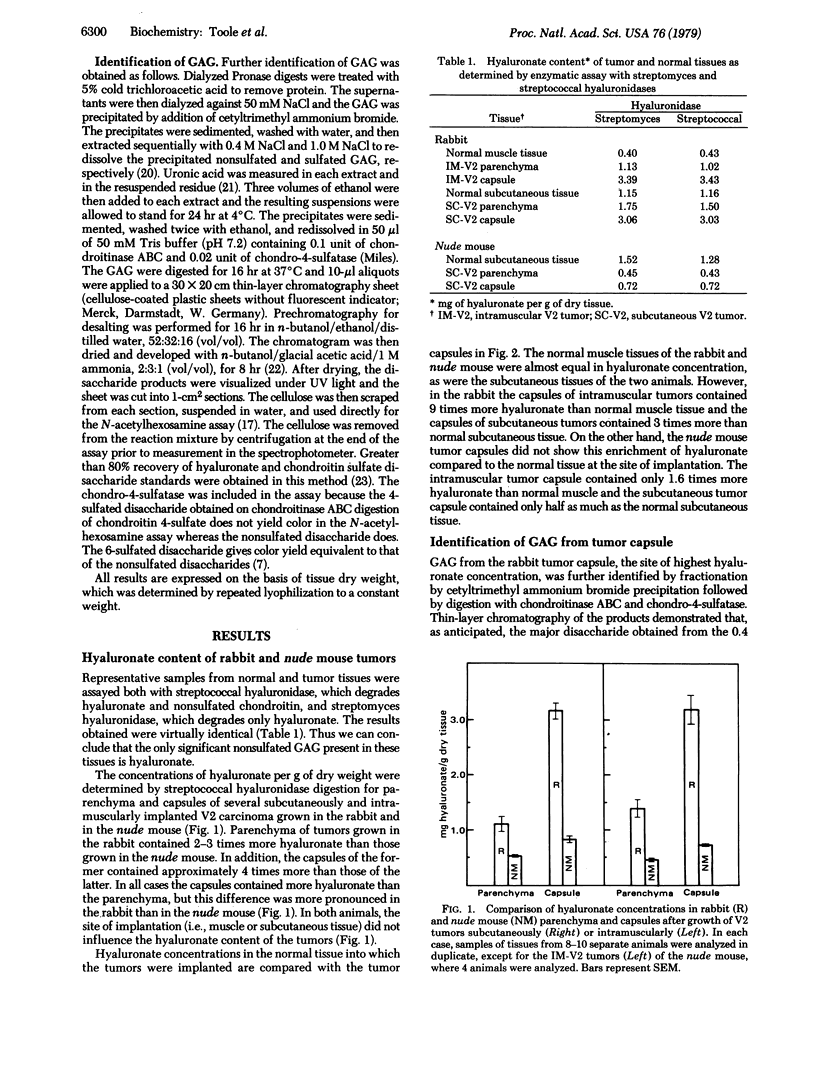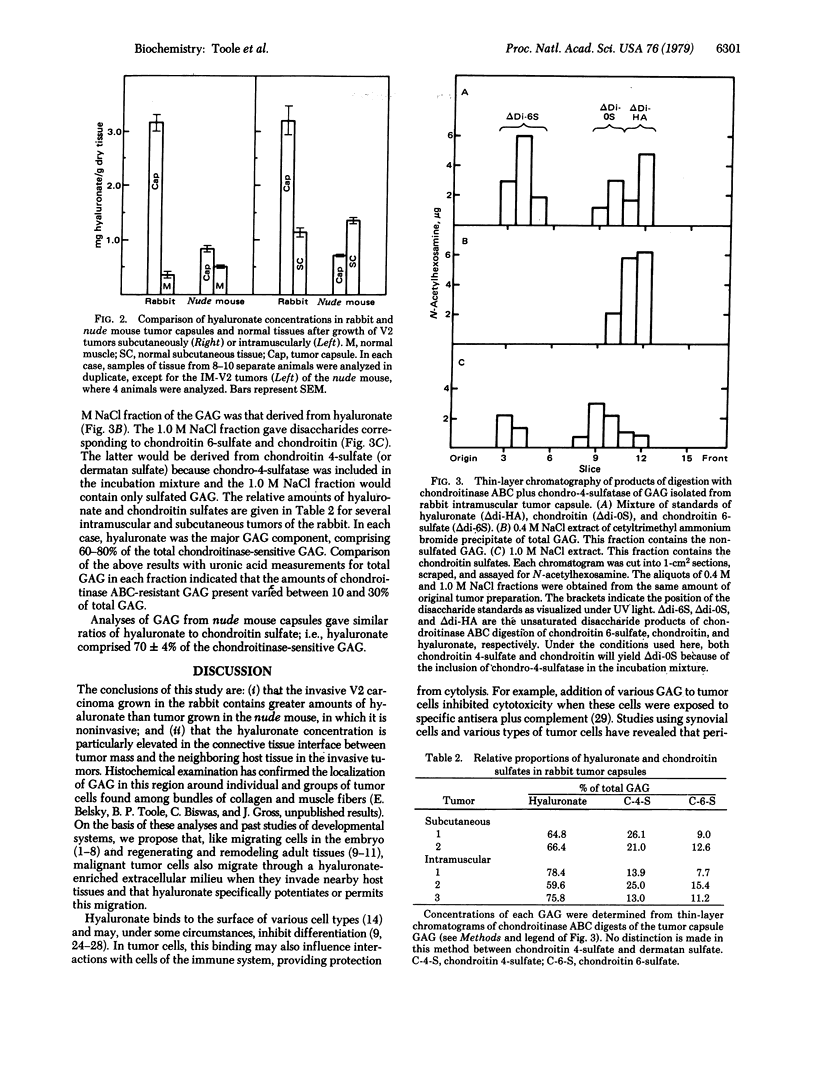Abstract
We propose that hyaluronate, a major component of extracellular matrices through which cells migrate during embryonic tissue development and in regenerative processes, is also concentrated in the environment through which neoplastic cells invade local host tissues and may facilitate this process. The hyaluronate content of invasive V2 carcinoma grown in rabbit was found to be 3-4 times greater than that of the same tumor grown in the nude mouse, in which it is noninvasive. Moreover, hyaluronate concentrations were most elevated in the connective tissue interface between the tumor mass and the neighboring host tissue in the invasive rabbit tumors. The particular site of tumor implantation in the rabbit or nude mouse did not affect the concentrations of hyaluronate in either the parenchyma or the surrounding connective tissue. Similar values were obtained for neoplasms grown in muscle, which normally contains little hyaluronate, and in subcutaneous tissue, which is relatively rich in this glycosaminoglycan.
Full text
PDF




Selected References
These references are in PubMed. This may not be the complete list of references from this article.
- BITTER T., MUIR H. M. A modified uronic acid carbazole reaction. Anal Biochem. 1962 Oct;4:330–334. doi: 10.1016/0003-2697(62)90095-7. [DOI] [PubMed] [Google Scholar]
- Bader J. P. Temperature-dependent transformation of cells infected with a mutant of Bryan Rous sarcoma virus. J Virol. 1972 Aug;10(2):267–276. doi: 10.1128/jvi.10.2.267-276.1972. [DOI] [PMC free article] [PubMed] [Google Scholar]
- Biswas C., Moran W. P., Bloch K. J., Gross J. Collagenolytic activity of rabbit V2-carcinoma growing at multiple sites. Biochem Biophys Res Commun. 1978 Jan 13;80(1):33–38. doi: 10.1016/0006-291x(78)91100-2. [DOI] [PubMed] [Google Scholar]
- Chandrasekaran E. V., Davidson E. A. Glycosaminoglycans of normal and malignant cultured human mammary cells. Cancer Res. 1979 Mar;39(3):870–880. [PubMed] [Google Scholar]
- Comper W. D., Laurent T. C. Physiological function of connective tissue polysaccharides. Physiol Rev. 1978 Jan;58(1):255–315. doi: 10.1152/physrev.1978.58.1.255. [DOI] [PubMed] [Google Scholar]
- Corsin J. Influence du hyaluronate et de la hyaluronidase sur la chondrogenèse cephalique chez les amphibiens. Acta Embryol Exp (Palermo) 1975;(1):15–22. [PubMed] [Google Scholar]
- Derby M. A. Analysis of glycosaminoglycans within the extracellular environments encountered by migrating neural crest cells. Dev Biol. 1978 Oct;66(2):321–336. doi: 10.1016/0012-1606(78)90241-5. [DOI] [PubMed] [Google Scholar]
- Duran-Reynals F. TISSUE PERMEABILITY AND THE SPREADING FACTORS IN INFECTION : A Contribution to the Host:Parasite Problem. Bacteriol Rev. 1942 Dec;6(4):197–252. doi: 10.1128/br.6.4.197-252.1942. [DOI] [PMC free article] [PubMed] [Google Scholar]
- Fraser J. R., Clarris B. J. On the reactions of human synovial cells exposed to homologous leucocytes in vitro. Clin Exp Immunol. 1970 Feb;6(2):211–225. [PMC free article] [PubMed] [Google Scholar]
- Glimelius B., Norling B., Westermark B., Wasteson A. Composition and distribution of glycosaminoglycans in cultures of human normal and malignant glial cells. Biochem J. 1978 Jun 15;172(3):443–456. doi: 10.1042/bj1720443. [DOI] [PMC free article] [PubMed] [Google Scholar]
- Glycosaminoglycans of cardiac tumors. Proc Soc Exp Biol Med. 1978 Mar;157(3):461–465. [PubMed] [Google Scholar]
- Hamerman D., Todaro G. J., Green H. The production of hyaluronate by spontaneously established cell lines and viral transformed lines of fibroblastic origin. Biochim Biophys Acta. 1965 Nov 1;101(3):343–351. doi: 10.1016/0926-6534(65)90013-8. [DOI] [PubMed] [Google Scholar]
- Handley C. J., Lowther D. A. Inhibition of proteoglycan biosynthesis by hyaluronic acid in chondrocytes in cell culture. Biochim Biophys Acta. 1976 Aug 24;444(1):69–74. doi: 10.1016/0304-4165(76)90224-5. [DOI] [PubMed] [Google Scholar]
- Hopwood J. J., Dorfman A. Glycosaminoglycan synthesis by Wilms' tumor. Pediatr Res. 1978 Jan;12(1):52–56. doi: 10.1203/00006450-197801000-00013. [DOI] [PubMed] [Google Scholar]
- Hopwood J. J., Dorfman A. Glycosaminoglycan synthesis by cultured human skin fibroblasts after transformation with simian virus 40. J Biol Chem. 1977 Jul 25;252(14):4777–4785. [PubMed] [Google Scholar]
- Ishimoto N., Temin H. M., Strominger J. L. Studies of carcinogenesis by avian sarcoma viruses. II. Virus-induced increase in hyaluronic acid synthetase in chicken fibroblasts. J Biol Chem. 1966 May 10;241(9):2052–2057. [PubMed] [Google Scholar]
- Kojima J., Nakamura N., Kanatani M., Omori K. The glycosaminoglycans in human hepatic cancer. Cancer Res. 1975 Mar;35(3):542–547. [PubMed] [Google Scholar]
- Lippman M. Transplantation and cytotoxicity changes induced by acid mucopolysaccharides. Nature. 1968 Jul 6;219(5149):33–36. doi: 10.1038/219033a0. [DOI] [PubMed] [Google Scholar]
- MAURER P. H., HUDACK S. S. The isolation of hyaluronic acid from callus tissue of early healing. Arch Biochem Biophys. 1952 Jul;38:49–53. doi: 10.1016/0003-9861(52)90008-8. [DOI] [PubMed] [Google Scholar]
- Markwald R. R., Fitzharris T. P., Bank H., Bernanke D. H. Structural analyses on the matrical organization of glycosaminoglycans in developing endocardial cushions. Dev Biol. 1978 Feb;62(2):292–316. doi: 10.1016/0012-1606(78)90218-x. [DOI] [PubMed] [Google Scholar]
- McBride W. H., Bard J. B. Hyaluronidase-sensitive halos around adherent cells. Their role in blocking lymphocyte-mediated cytolysis. J Exp Med. 1979 Feb 1;149(2):507–515. doi: 10.1084/jem.149.2.507. [DOI] [PMC free article] [PubMed] [Google Scholar]
- McClean D. Studies on diffusing factors: The hyaluronidase activity of testicular extracts, bacterial culture filtrates and other agents that increase tissue permeability. Biochem J. 1941 Jan;35(1-2):159–183. doi: 10.1042/bj0350159. [DOI] [PMC free article] [PubMed] [Google Scholar]
- Mikuni-Takagaki Y., Toole B. P. Shedding of hyaluronate from the cell surface of Rous sarcoma virus-transformed chondrocytes. J Biol Chem. 1979 Sep 10;254(17):8409–8415. [PubMed] [Google Scholar]
- Ohya T., Kaneko Y. Novel hyaluronidase from streptomyces. Biochim Biophys Acta. 1970 Mar 18;198(3):607–609. doi: 10.1016/0005-2744(70)90139-7. [DOI] [PubMed] [Google Scholar]
- Orkin R. W., Toole B. P. Hyaluronidase activity and hyaluronate content of the developing chick embryo heart. Dev Biol. 1978 Oct;66(2):308–320. doi: 10.1016/0012-1606(78)90240-3. [DOI] [PubMed] [Google Scholar]
- Pintar J. E. Distribution and synthesis of glycosaminoglycans during quail neural crest morphogenesis. Dev Biol. 1978 Dec;67(2):444–464. doi: 10.1016/0012-1606(78)90211-7. [DOI] [PubMed] [Google Scholar]
- Pratt R. M., Larsen M. A., Johnston M. C. Migration of cranial neural crest cells in a cell-free hyaluronate-rich matrix. Dev Biol. 1975 Jun;44(2):298–305. doi: 10.1016/0012-1606(75)90400-5. [DOI] [PubMed] [Google Scholar]
- REISSIG J. L., STORMINGER J. L., LELOIR L. F. A modified colorimetric method for the estimation of N-acetylamino sugars. J Biol Chem. 1955 Dec;217(2):959–966. [PubMed] [Google Scholar]
- Reid T., Flint M. H. Changes in glycosaminoglycan content of healing rabbit tendon. J Embryol Exp Morphol. 1974 Apr;31(2):489–495. [PubMed] [Google Scholar]
- SCOTT J. E. Aliphatic ammonium salts in the assay of acidic polysaccharides from tissues. Methods Biochem Anal. 1960;8:145–197. doi: 10.1002/9780470110249.ch4. [DOI] [PubMed] [Google Scholar]
- Sato C., Banks J., Horst P., Kreider J. W., Davidson E. A. Polysaccharide production by cultured B-16 mouse melanoma cells. Biochemistry. 1974 Mar 12;13(6):1233–1241. doi: 10.1021/bi00703a028. [DOI] [PubMed] [Google Scholar]
- Satoh C., Duff R., Rapp F., Davidson E. A. Production of mucopolysaccharides by normal and transformed cells. Proc Natl Acad Sci U S A. 1973 Jan;70(1):54–56. doi: 10.1073/pnas.70.1.54. [DOI] [PMC free article] [PubMed] [Google Scholar]
- Solursh M. Glycosaminoglycan synthesis in the chick gastrula. Dev Biol. 1976 Jun;50(2):525–530. doi: 10.1016/0012-1606(76)90171-8. [DOI] [PubMed] [Google Scholar]
- Solursh M., Vaerewyck S. A., Reiter R. S. Depression by hyaluronic acid of glycosaminoglycan synthesis by cultured chick embryo chondrocytes. Dev Biol. 1974 Dec;41(2):233–244. doi: 10.1016/0012-1606(74)90302-9. [DOI] [PubMed] [Google Scholar]
- Sträuli P., Weiss L. Cell locomation and tumor penetration. Report on a workshop of the EORTC cell surface project group. Eur J Cancer. 1977 Jan;13(1):1–12. doi: 10.1016/0014-2964(77)90222-5. [DOI] [PubMed] [Google Scholar]
- Takeuchi J., Sobue M., Sato E., Shamoto M., Miura K. Variation in glycosaminoglycan components of breast tumors. Cancer Res. 1976 Jul;36(7 Pt 1):2133–2139. [PubMed] [Google Scholar]
- Toole B. P., Gross J. The extracellular matrix of the regenerating newt limb: synthesis and removal of hyaluronate prior to differentiation. Dev Biol. 1971 May;25(1):57–77. doi: 10.1016/0012-1606(71)90019-4. [DOI] [PubMed] [Google Scholar]
- Toole B. P. Hyaluronate turnover during chondrogenesis in the developing chick limb and axial skeleton. Dev Biol. 1972 Nov;29(3):321–329. doi: 10.1016/0012-1606(72)90071-1. [DOI] [PubMed] [Google Scholar]
- Toole B. P., Trelstad R. L. Hyaluronate production and removal during corneal development in the chick. Dev Biol. 1971 Sep;26(1):28–35. doi: 10.1016/0012-1606(71)90104-7. [DOI] [PubMed] [Google Scholar]
- Tosney K. W. The early migration of neural crest cells in the trunk region of the avian embryo: an electron microscopic study. Dev Biol. 1978 Feb;62(2):317–333. doi: 10.1016/0012-1606(78)90219-1. [DOI] [PubMed] [Google Scholar]
- Underhill C. B., Toole B. P. Binding of hyaluronate to the surface of cultured cells. J Cell Biol. 1979 Aug;82(2):475–484. doi: 10.1083/jcb.82.2.475. [DOI] [PMC free article] [PubMed] [Google Scholar]
- VASILIEV J. M. The role of connective tissue proliferation in invasive growth of normal and malignant tissues: a review. Br J Cancer. 1958 Dec;12(4):524–536. doi: 10.1038/bjc.1958.61. [DOI] [PMC free article] [PubMed] [Google Scholar]
- Wasserman L., Ber A., Allalouf D. Use of thin-layer chromatography in the separation of disaccharides resulting from digestion of chondroitin sulphates with chondroitinases. J Chromatogr. 1977 Jun 11;136(2):342–347. doi: 10.1016/s0021-9673(00)86291-3. [DOI] [PubMed] [Google Scholar]
- Wiebkin O. W., Muir H. The inhibition of sulphate incorporation in isolated adult chondrocytes by hyaluronic acid. FEBS Lett. 1973 Nov 15;37(1):42–46. doi: 10.1016/0014-5793(73)80422-3. [DOI] [PubMed] [Google Scholar]


